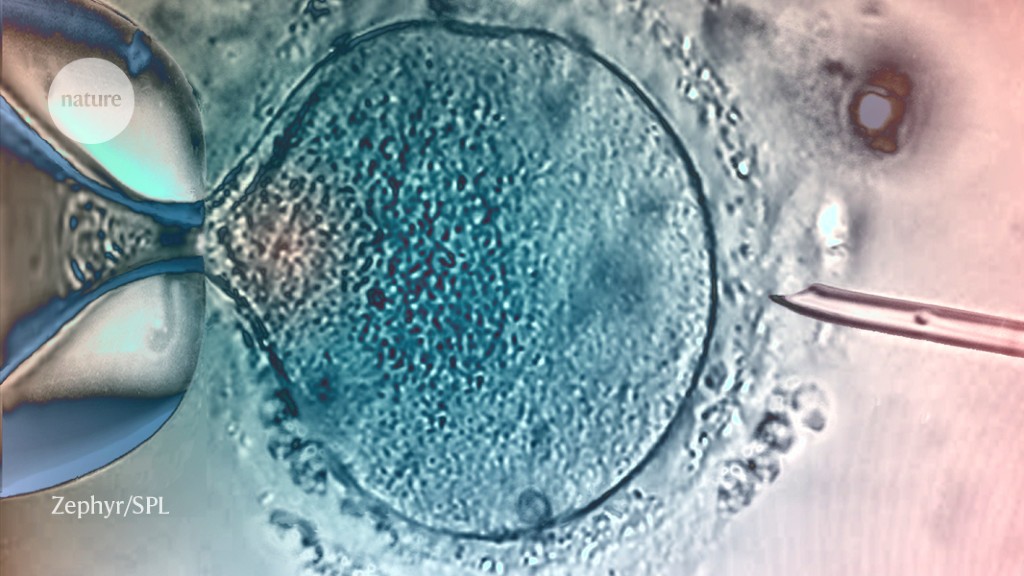First UK mitochondrial replacements: what scientists want to know

British fertility regulator has revealed that the controversial treatment has been used to create a child, but details are scant

Mitochondrial replacement therapy is an in vitro fertilization technique that involves the DNA of three people.Credit: Zephyr/Science Photo Library
Eight years after the United Kingdom became the first country to regulate the reproductive technique known as mitochondrial replacement, news has emerged that children have been born using the procedure.
The Human Fertilisation and Embryology Authority (HFEA), the UK fertility regulator, confirmed that “less than five” UK children had been born using the procedure as of April 2023, in response to a freedom of information request by The Guardian newspaper. The HFEA provided no further information about the procedure or the children.
“It’s exciting news, but at the same time it doesn’t tell us anything about whether the method has actually worked,” says Dagan Wells, a reproductive geneticist at the University of Oxford, UK. “There are open questions, and we need to get answers as soon as possible.”
Mitochondrial replacement therapy (MRT) is intended to prevent the inheritance of serious health conditions caused by mutations to mitochondria, cells’ energy producing organelles, often affecting the heart, brain and muscles, and was legalized in the United Kingdom 2015.
The procedure — sometimes called three-person in vitro fertilization (IVF) — involves moving nuclear genetic material from an egg or single-cell embryo with disease-causing mitochondria to a donor egg or embryo that has had its nuclear genetic material removed.
Grey regulation
The procedure has been performed in other countries where its use is not regulated. In 2016, a US doctor announced that he had used MRT successfully to prevent mitochondrial disease in a baby, in a procedure conducted in Mexico. Children have also been born through mitochondrial transfers conducted in Greece and Ukraine to treat infertility. Last year, Australia became the second country to approve MRT. But the procedure remains restricted in many other countries, including the United States.
The mitochondrial transfers uncovered by The Guardian were done at the Newcastle Fertility Centre, the only UK clinic with a licence to conduct MRT. Under current regulations, the HFEA must approve each use on a case-by-case basis.
Researchers are anxious to learn more from the UK procedures as they start to conduct their own trials. “If there are any negative things to be considered, we need to know about those sooner rather than later,” says Wells.
Knowing how well the procedures worked and whether the babies are free of mitochondrial disease is crucial, according to Robin Lovell-Badge, a developmental biologist at the Francis Crick Institute in London, who gave a statement to the UK Science Media Centre. Lovell-Badge also wants to know “whether there is any risk of them developing problems later in life or, if female, if their offspring are at risk of having the disease.”
This might happen during the procedure, when inevitably a small number of mitochondria are transferred into the donor egg or embryo. Wells wants to know the extent of this ‘carry-over’ in the UK cases and whether or not very low levels of mutation-bearing mitochondria cause health problems.
Mutant mitochondria
Scientists also want to know whether the levels of mutant mitochondria that are transferred remain stable over time. Animal and cell studies have found that in some cases the carried-over mitochondria can dramatically increase over time, replacing donor mitochondria in cells, a phenomenon known as reversal1.
And this can happen in humans. This year, Wells and his colleagues observed reversal after using MRT to treat infertility in a trial of 25 couples in Greece. Of the 6 children born, 5 had mitochondrial DNA almost entirely from the donor in cells from blood, umbilical cord and other tissues sampled. However, one child’s cells had high levels of mitochondria inherited from the mother — 30–60% of the total. When the embryo was implanted, less than 1% of its mitochondria were carried over from the maternal egg2.
The reversal seems to have had no effect on the child’s health. “If we had been doing the same procedure to avoid a mitochondrial DNA disorder, then this might be a cause for concern,” says Wells. “So that’s a big question we have: has any reversal been seen in any of these children?”
It’s not clear why the proportion of potentially disease-causing mitochondria can increase so dramatically after mitochondrial transfer and during development. One possibility, is that genetic factors enable the maternal mitochondrial lineage to replicate more efficiently than mitochondria in donor egg or embryo, says Wells. If this is the case, then it might be worth matching the donor and recipient based on similarities in their mitochondrial DNA, he adds, potentially reducing the ability of one lineage to out-replicate another.
There may be other ways to prevent reversal, says Shoukrhat Mitalipov, a reproductive biologist at the Oregon Health & Science University in Portland who was part of the infertility trial. In the 5 children that gained nearly all their mitochondria from a donor, the researchers froze the mother’s eggs and transferred them into fresh donor eggs. Both eggs were fresh during the transfer that created the child in which reversal occurred. “We’re still puzzled as to whether freezing mother’s egg is actually beneficial,” he says.
The first UK births from MRT also provide an opportunity to take stock of the country’s cautious approach to allowing the procedure.
“It gives the general public some reassurance that these kinds of cutting-edge procedures — which push scientific but also ethical boundaries — are being done with appropriate oversight,” says Wells. But the fact that just one UK clinic can perform MRT has probably created a bottleneck for treatment, he adds. “There are pluses and minuses.”
doi: https://doi.org/10.1038/d41586-023-01585-x
This story originally appeared on: Nature - Author:Ewen Callaway

















